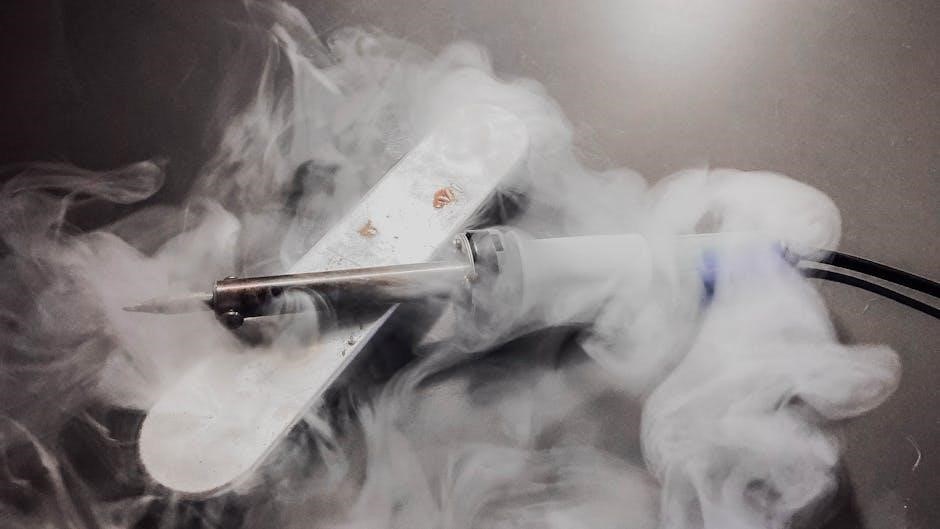Welcome to the Honeywell Heat Pump Thermostat Manual‚ your guide to understanding and optimizing your heating and cooling system․ This manual provides detailed instructions‚ troubleshooting tips‚ and advanced features to help you maximize energy efficiency and comfort․ Whether you’re installing a new thermostat or maintaining an existing one‚ this resource offers comprehensive support for all your HVAC needs․
Overview of Honeywell Thermostats
Honeywell thermostats are renowned for their reliability and innovative features‚ catering to both residential and commercial needs․ With a wide range of models‚ from basic non-programmable to advanced smart thermostats‚ Honeywell offers solutions for every user․ Their heat pump thermostats are designed to optimize energy efficiency and comfort‚ featuring intuitive interfaces and customizable settings․ Whether you prefer simple temperature control or advanced geofencing and smart home integration‚ Honeywell provides user-friendly options․ Their thermostats are trusted for their durability and adaptability‚ making them a popular choice for modern HVAC systems․
Importance of Using a Manual for Heat Pump Thermostats
Using a manual for your Honeywell heat pump thermostat is essential for optimal performance and efficiency․ It provides detailed guidance on installation‚ programming‚ and troubleshooting‚ ensuring you understand all features and settings․ The manual helps you navigate complex functions like temperature limits and error codes‚ while also outlining safety precautions to prevent system malfunctions․ By following the manual‚ you can customize settings to maximize energy savings and comfort‚ making it an indispensable resource for both new and experienced users․

Understanding Your Honeywell Heat Pump Thermostat
Your Honeywell heat pump thermostat is designed to regulate your HVAC system efficiently‚ offering programmable and non-programmable options․ It adapts to your schedule and preferences‚ ensuring comfort and energy savings․
Key Components of the Thermostat
Your Honeywell heat pump thermostat features a user-friendly interface with essential components like the display screen‚ temperature sensors‚ and control buttons․ The wiring terminals connect to your HVAC system‚ enabling precise temperature regulation․ Advanced models include a touchscreen interface for easy navigation and programmable settings; Additional components may include geofencing capabilities‚ smart sensors‚ and Wi-Fi connectivity for remote access․ Understanding these components ensures optimal performance and customization of your heating and cooling system․ Regular maintenance of these parts is crucial for long-term efficiency and reliability․
Basic Functions and Features
Your Honeywell heat pump thermostat offers essential functions for temperature control‚ including heat‚ cool‚ and emergency heat modes․ It features a programmable schedule to automate settings‚ optimizing energy use․ The touchscreen interface provides easy navigation‚ while geofencing and smart home integration enhance convenience․ Energy-saving modes and temperature range customization help reduce utility bills․ Some models include remote access via Wi-Fi‚ allowing adjustments from your smartphone․ These features ensure efficient heating and cooling‚ tailored to your lifestyle and preferences‚ while maintaining comfort and energy efficiency year-round․
Differences Between Programmable and Non-Programmable Models
Programmable Honeywell heat pump thermostats allow users to set temperature schedules‚ optimizing energy use by adjusting settings automatically․ They offer advanced features like energy-saving modes and remote access via Wi-Fi․ Non-programmable models‚ while simpler‚ provide basic temperature control without scheduling‚ making them ideal for straightforward heating and cooling needs․ Programmable models suit households with varying routines‚ while non-programmable options are better for consistent temperature preferences․ Both ensure reliable performance‚ but programmable thermostats offer greater flexibility and energy efficiency for modern lifestyles․

Installation and Setup
Installation involves turning off power‚ removing the old thermostat‚ and connecting wires to the new Honeywell heat pump thermostat․ Setup includes programming and configuring settings․
Pre-Installation Checks
Before installing your Honeywell heat pump thermostat‚ ensure compatibility with your HVAC system․ Verify the thermostat model supports your heat pump type․ Check wiring compatibility to avoid electrical issues․ Turn off power to the HVAC system at the circuit breaker for safety․ Gather all necessary tools and materials․ Review the manual to confirm system requirements․ Ensure the thermostat is compatible with your home’s voltage and wiring configuration․ Double-check the compatibility chart provided by Honeywell․ This ensures a smooth and safe installation process․
Step-by-Step Installation Guide
Begin by turning off the power to your HVAC system at the circuit breaker․ Remove the old thermostat and label the wires for easy identification․ Mount the new thermostat base‚ ensuring it is level and securely attached to the wall․ Connect the wires to the corresponding terminals‚ referencing the Honeywell wiring diagram․ Tighten all connections firmly․ Restore power and test the system to ensure proper operation․ Finally‚ program the thermostat to your desired settings‚ following the on-screen prompts for a seamless setup․
Wiring Diagrams and Connections
Refer to the Honeywell wiring diagram provided in the manual or online․ Identify the terminals (e․g․‚ R‚ C‚ W‚ Y‚ G‚ O‚ B) and match them to your system․ Connect the wires carefully‚ ensuring no loose connections․ Use the diagram specific to your heat pump model for accuracy․ Double-check the wiring before powering up the system․ If unsure‚ consult a professional to avoid damage or safety hazards․ Proper connections are critical for optimal thermostat performance and system functionality․

Programming Your Honeywell Heat Pump Thermostat
Programming your Honeywell thermostat allows you to customize temperature settings for comfort and efficiency․ Follow the manual to set schedules‚ enable smart features‚ and optimize energy use․
How to Set Up a Daily Schedule
To set up a daily schedule on your Honeywell heat pump thermostat‚ access the menu and select the “Schedule” option․ Choose between a 7-day‚ 5-day‚ or 6-day schedule․ Set specific times for wake‚ leave‚ return‚ and sleep periods․ Adjust the desired temperatures for each timeframe using the up/down arrows․ Save your changes to activate the schedule․ This feature allows you to optimize comfort and energy efficiency by automating temperature adjustments․ Ensure to review and adjust the schedule as needed to match your lifestyle and preferences․
Understanding Programming Options for Heat Pumps
Honeywell heat pump thermostats offer advanced programming options to optimize performance․ These include settings for auxiliary heat‚ dual-fuel systems‚ and geothermal configurations․ Smart recovery and adaptive algorithms learn your system’s needs‚ improving efficiency․ You can customize temperature ranges for heating and cooling stages‚ ensuring comfort while minimizing energy use․ These options are designed to work seamlessly with heat pump systems‚ providing precise control and maximizing savings․ Always refer to your specific model’s manual for detailed instructions on configuring these settings for your unique setup․
How to Use the Touchscreen Interface
The Honeywell heat pump thermostat features an intuitive touchscreen interface designed for easy navigation․ Tap the screen to access menus‚ adjust settings‚ and view system status․ Use the brightness control to customize the display for optimal visibility․ Swipe left or right to navigate between screens‚ and press the “Menu” button to access advanced options․ Programming schedules‚ adjusting temperatures‚ and enabling features like geofencing can all be done with a few taps․ The interface also provides real-time feedback‚ ensuring smooth operation and precise control over your heat pump system․

Operating Modes and Settings
Honeywell heat pump thermostats offer Heat‚ Cool‚ and Emergency Heat modes․ Adjust temperature settings‚ fan speeds‚ and system operation to optimize comfort and energy efficiency easily․
Heat Mode Operation
In Heat Mode‚ the Honeywell thermostat activates the heat pump to warm your home․ It regulates temperature by adjusting the system’s output‚ ensuring consistent comfort․ The thermostat automatically switches to auxiliary heat if the desired temperature isn’t reached quickly․ Users can adjust settings like temperature range and fan speed for optimal performance․ The interface allows easy scheduling and energy-efficient operation‚ ensuring your home stays cozy while managing energy use effectively․
Cool Mode Operation
In Cool Mode‚ the Honeywell thermostat engages the heat pump to cool your home by transferring heat from indoors to outdoors․ The system adjusts fan speed and compressor operation to maintain the set temperature‚ ensuring consistent comfort․ Users can customize settings like temperature range and humidity control for optimal performance․ The thermostat also offers energy-saving features‚ such as automatic fan operation‚ to balance efficiency and cooling effectiveness․ This mode is designed to provide reliable cooling while minimizing energy consumption‚ keeping your home comfortable during warmer months․
Emergency Heat Mode Explained
Emergency Heat Mode is a backup heating option that activates when the heat pump cannot maintain the desired temperature‚ often due to extreme cold or system issues․ This mode switches to an auxiliary heat source‚ such as electric resistance heating‚ to warm your home․ The thermostat automatically enables this mode when the heat pump struggles to keep up‚ ensuring consistent warmth․ It’s designed as a fail-safe to prevent discomfort during harsh conditions․ Use this mode sparingly‚ as it can increase energy consumption․ Always monitor its activation to address any underlying issues with your heat pump system․
Troubleshooting Common Issues
Identify and resolve issues like power outages‚ sensor malfunctions‚ or wiring faults․ Check circuits‚ ensure proper connections‚ and restart the thermostat to restore functionality․
Identifying and Solving Error Codes
When error codes appear on your Honeywell thermostat‚ refer to the manual for specific meanings․ Common codes like E1 or E2 often indicate temperature or sensor issues․ Check if the displayed temperature matches the setpoint․ Ensure all sensors are clean and properly installed․ Restart the thermostat by switching it off and on․ If the issue persists‚ consult the troubleshooting section or contact Honeywell support for assistance․ Always follow the recommended steps to resolve errors and maintain optimal system performance․ Regular checks can prevent recurring issues․
Resolving Temperature Setting Limitations
If your Honeywell thermostat restricts temperature adjustments‚ check if the lock screen feature is enabled․ Navigate to settings and ensure temperature limits are not set too narrow․ Verify the system is not in emergency heat mode‚ as this can restrict normal temperature adjustments․ Resetting the thermostat to its default settings may resolve the issue․ Consult the manual for guidance on adjusting temperature ranges and ensure the thermostat is properly configured for your heat pump system․ If limitations persist‚ contact Honeywell support for further assistance․
Fixing System Malfunctions
To address system malfunctions‚ start by checking the power supply and ensuring the thermostat is properly connected․ Verify that all wiring connections match the diagram in the manual․ If the system fails to respond‚ reset the thermostat by turning it off and on again․ Ensure the heat pump is in the correct mode (heat or cool)․ If issues persist‚ check for loose connections or damaged wires․ Consult the troubleshooting section of the manual for specific error solutions․ If problems remain unresolved‚ contact a licensed HVAC technician or Honeywell customer support for professional assistance․

Maintenance and Care
Regularly clean the thermostat and check air filters to ensure optimal performance․ Schedule annual HVAC system check-ups and maintain proper installation to prevent malfunctions․
Cleaning the Thermostat
Cleaning your Honeywell heat pump thermostat is essential for maintaining accuracy and functionality․ Use a soft‚ dry cloth to gently wipe the display and exterior․ Avoid liquids or harsh chemicals‚ as they may damage the screen or internal components․ For a more thorough clean‚ turn off the thermostat‚ remove the cover‚ and use compressed air to dust internal parts․ Regular cleaning prevents dust buildup‚ ensuring precise temperature readings and smooth operation․ Always power down the device before cleaning to avoid electrical issues or temporary malfunctions․
Regular Maintenance Routines
Regular maintenance ensures your Honeywell heat pump thermostat operates efficiently and accurately․ Replace batteries annually if it’s a battery-powered model‚ or check the wiring for hardwired units․ Update software periodically to access new features and improvements․ Inspect the wiring connections to prevent loose links‚ which can cause malfunctions․ Clean or replace air filters every 1-3 months to maintain proper airflow․ Check the thermostat’s calibration annually to ensure accurate temperature readings․ Schedule professional HVAC system checks to complement thermostat maintenance‚ ensuring optimal performance and energy efficiency throughout the year․
When to Replace the Thermostat
Replace your Honeywell heat pump thermostat if it exceeds its 10-15 year lifespan or shows signs of aging․ If the thermostat fails to maintain consistent temperatures‚ has unresponsive controls‚ or requires frequent resets‚ consider upgrading․ Old or damaged thermostats can lead to inefficient heating and cooling․ Additionally‚ if your system requires advanced features like smart home integration or geofencing‚ a modern thermostat may be necessary; Finally‚ replace the thermostat if it no longer communicates effectively with your HVAC system or if repairs become repetitive and costly․

Advanced Features and Customization
Honeywell thermostats offer programmable scheduling‚ geofencing‚ and smart home integration․ Customize temperature ranges‚ set energy-saving programs‚ and lock settings for enhanced control and efficiency․
Geofencing and Smart Home Integration
Honeywell heat pump thermostats offer advanced geofencing capabilities‚ automatically adjusting temperatures based on your location․ This feature ensures energy efficiency by switching to savings mode when you leave home․ Integration with smart home systems like Amazon Alexa and Google Home allows voice control and seamless app management․ Users can also receive alerts and monitor system performance remotely․ These features enhance convenience‚ optimize energy use‚ and provide a modern‚ connected home experience․ Regular updates ensure compatibility with the latest smart home technologies‚ making Honeywell thermostats a versatile choice for smart energy management․
Customizing Temperature Ranges
Honeywell heat pump thermostats allow users to customize temperature ranges for optimal comfort and efficiency․ By adjusting the upper and lower temperature limits‚ you can prevent extreme settings and reduce energy waste․ For example‚ setting a cooling range of 68°F to 78°F and a heating range of 65°F to 75°F ensures balanced comfort; These settings can be tailored to your preferences via the thermostat’s menu or the Honeywell Home app․ Custom temperature ranges help maintain energy efficiency while keeping your home cozy year-round․ Always refer to your manual for model-specific customization options․
Locking and Unlocking the Thermostat
Honeywell heat pump thermostats offer lock and unlock features to prevent unauthorized adjustments․ This is ideal for maintaining consistent settings in commercial spaces or homes with children․ The lock function can be enabled through the thermostat’s menu or the Honeywell Home app․ Partial locking allows limited adjustments‚ while full locking restricts all changes․ To unlock‚ enter the PIN or use the app․ Some models require a physical button press and code entry․ Locking ensures energy-saving settings remain intact and reduces tampering․ Always check your manual for specific locking options available on your thermostat model․
Energy Efficiency and Savings
Honeywell heat pump thermostats optimize energy use through smart scheduling‚ geofencing‚ and adaptive learning‚ reducing waste and lowering utility bills while maintaining comfort and efficiency․
How to Set Energy-Saving Programs
To maximize efficiency‚ start by understanding your Honeywell thermostat’s features․ Use the touchscreen interface or app to set a daily schedule‚ adjusting temperatures for times you’re away or sleeping․ Enable geofencing to automatically adjust settings based on your location․ Take advantage of heat pump-specific programs to optimize energy use․ Monitor your energy usage through the app to ensure your settings are effective․ Gradually add more complex settings as you gain confidence․ Consider local rebates for smart thermostat use and maintain your device regularly for optimal performance․ If issues arise‚ consult Honeywell support for troubleshooting․
Understanding Energy Usage Reports
Your Honeywell thermostat generates detailed energy usage reports to help you track consumption patterns․ These reports provide insights into daily energy use‚ breaking it down into heating‚ cooling‚ and fan operations․ Access these reports via the touchscreen interface or the Honeywell Home app․ Use the data to identify trends and opportunities to save energy․ Regularly reviewing these reports allows you to optimize your settings for greater efficiency and cost savings․ This feature is especially useful for heat pump systems‚ where energy use can vary significantly based on external temperatures and operating modes․
Role of the Thermostat in Energy Efficiency
Your Honeywell thermostat plays a crucial role in enhancing energy efficiency by optimizing your heat pump’s performance․ It ensures precise temperature control‚ reducing unnecessary heating or cooling․ Features like smart sensing‚ geofencing‚ and adaptive learning adjust settings based on your schedule and preferences․ By maintaining consistent temperatures and minimizing runtime‚ the thermostat helps lower energy consumption․ Additionally‚ it integrates with smart home systems to provide real-time energy usage data‚ enabling smarter decisions for further savings․ This advanced technology ensures your system operates efficiently while maintaining comfort․

Safety Precautions and Best Practices
Always turn off power before installation or maintenance․ Follow Honeywell’s guidelines to avoid damage or hazards․ Ensure proper installation to prevent system malfunctions and safety risks․
Safety Guidelines for Installation and Use
Always disconnect power before installing or servicing the thermostat to prevent electrical shock․ Follow the manual’s instructions carefully to avoid damaging the device or causing safety hazards․ Ensure the system is properly grounded and wired according to local codes․ Keep the thermostat out of reach of children and avoid exposing it to extreme temperatures or moisture․ Wear protective gear during installation‚ such as gloves and safety glasses․ Never bypass safety features or override default settings without proper knowledge․ Refer to the manual for detailed safety precautions and guidelines․
Best Practices for Thermostat Usage
To optimize performance and efficiency‚ adjust temperature settings based on occupancy and seasonal changes․ Regularly review and update your schedule to match your lifestyle․ Avoid extreme temperature swings‚ as they can increase energy consumption․ Ensure proper airflow by keeping vents unobstructed and maintaining consistent temperatures between zones․ Use features like geofencing to automate settings when you’re away․ Periodically check wiring and connections to prevent malfunctions․ Replace batteries promptly to avoid system interruptions․ Always reference the manual for specific recommendations tailored to your Honeywell heat pump thermostat model․
Emergency Procedures
- In case of system failure‚ turn off power at the circuit breaker and restart the thermostat․
- For extreme temperature issues‚ activate emergency heat mode if available․
- Never attempt DIY repairs; contact a certified technician immediately․
- Keep emergency contacts‚ like Honeywell support‚ readily available․
- Ensure all safety precautions are followed to prevent further damage or hazards․

Frequently Asked Questions
This section addresses common inquiries about Honeywell heat pump thermostat functionality‚ troubleshooting‚ and maintenance‚ ensuring users can resolve issues and optimize performance effectively․
Common Questions About Heat Pump Thermostats
Users often ask about compatibility with their HVAC systems‚ how to optimize temperature settings‚ and the difference between programmable and non-programmable models․ Many inquire about emergency heat operation‚ geofencing capabilities‚ and how to integrate the thermostat with smart home systems․ Others seek clarity on energy-saving features‚ such as adaptive recovery and smart alerts․ Additionally‚ questions arise about troubleshooting common issues like error codes and temperature inaccuracies․ This section provides clear‚ concise answers to these frequently asked questions‚ helping users maximize their thermostat’s performance and efficiency․
Questions About Programming and Settings
Users often ask how to set up daily schedules‚ adjust temperature ranges‚ and enable features like geofencing; Many wonder about the differences between programmable and non-programmable models and how to customize settings for energy efficiency․ Questions also arise about smart alerts‚ adaptive recovery‚ and how to lock or unlock the thermostat․ This section addresses these inquiries‚ providing step-by-step guidance on programming options‚ temperature adjustments‚ and advanced settings to ensure optimal performance and personalized comfort․ It helps users make the most of their thermostat’s features․
Questions About Maintenance and Troubleshooting
Common questions include how to clean the thermostat‚ resolve error codes‚ and fix temperature inaccuracies․ Users often ask about rebooting the system or addressing wiring issues․ Many inquire about replacing batteries or checking system compatibility․ This section provides solutions for malfunctioning sensors‚ incorrect temperature settings‚ and error code interpretations․ It also offers guidance on maintaining the thermostat’s performance and troubleshooting common issues to ensure reliable operation and energy efficiency․ Regular maintenance tips are included to prevent future problems and extend the thermostat’s lifespan․

Additional Resources
This section offers access to the official full manual online‚ detailed video tutorials‚ and Honeywell customer support contact information for further assistance and troubleshooting․
Where to Find the Full Manual Online
The full Honeywell heat pump thermostat manual is available on Honeywell’s official website․ Visit the support section‚ enter your model number‚ and download the PDF․ Additional resources like interactive guides and troubleshooting tips are also accessible․ For convenience‚ the manual can be found through Honeywell’s customer portal or authorized distributors․ Ensure to verify the source for authenticity to avoid outdated or incorrect information․ The online manual is regularly updated‚ providing the most accurate and detailed instructions for installation‚ programming‚ and maintenance․ This resource is essential for maximizing your thermostat’s performance and troubleshooting effectively․
Recommended Videos and Tutorials
Honeywell offers a variety of instructional videos and tutorials to help users master their heat pump thermostat․ These resources are available on Honeywell’s official YouTube channel and website․ Topics range from basic installation to advanced programming features․ Additionally‚ authorized distributors and retailers like Amazon often host video guides․ These tutorials are designed to cater to both DIY enthusiasts and professionals‚ ensuring a smooth learning curve․ By exploring these visual aids‚ users can gain a deeper understanding of their thermostat’s capabilities and optimize its performance for energy efficiency and comfort․
Honeywell Customer Support Contact Information
For assistance with your Honeywell heat pump thermostat‚ contact their customer support team․ You can reach them by phone at 1-800-468-1502 or visit their official website at www․honeywell․com․ Live chat is also available on their website for quick inquiries․ Additionally‚ Honeywell provides 24/7 support for urgent issues․ Ensure to have your thermostat model number ready for faster assistance․ Their team is prepared to address installation‚ programming‚ and troubleshooting concerns‚ offering tailored solutions to optimize your thermostat’s performance․
By following this manual‚ you’ve mastered your Honeywell heat pump thermostat․ Proper use enhances energy efficiency‚ comfort‚ and system longevity․ Refer back for any future adjustments or troubleshooting․
Final Tips for Optimizing Your Thermostat
Regularly update your Honeywell thermostat’s software for optimal performance․ Adjust temperature settings based on occupancy and outdoor conditions to maximize energy efficiency․ Utilize smart features like geofencing to automate temperature changes․ Monitor system performance regularly to identify and address potential issues early․ Enable energy-saving programs tailored to your daily routine․ Lock the thermostat when not in use to prevent accidental changes‚ ensuring consistent and efficient heating and cooling․ These practices enhance efficiency‚ comfort‚ and system longevity‚ helping you get the most out of your Honeywell thermostat․
